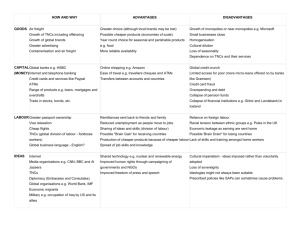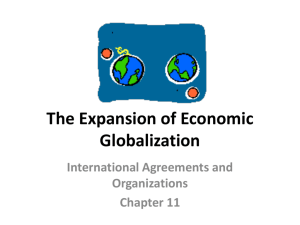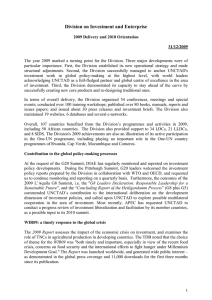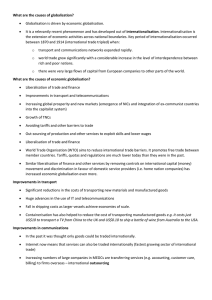GLOBALIZATION OF R&D AND DEVELOPING COUNTRIES PREFACE & OVERVIEW
advertisement
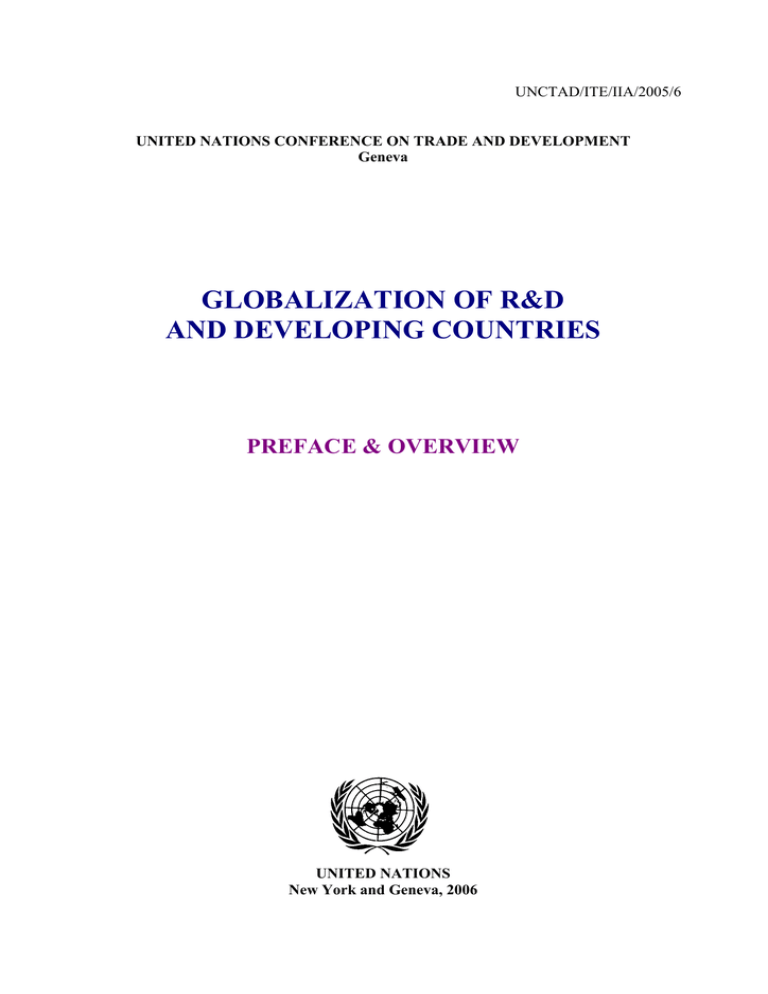
UNCTAD/ITE/IIA/2005/6 UNITED NATIONS CONFERENCE ON TRADE AND DEVELOPMENT Geneva GLOBALIZATION OF R&D AND DEVELOPING COUNTRIES PREFACE & OVERVIEW UNITED NATIONS New York and Geneva, 2006 PREFACE Reflecting a broader trend towards the offshoring of services, a number of developing countries are attracting foreign direct investment in research and development. Transnational corporations, including the ones headquartered in developing countries, are selecting developing countries as locations for such activities. With the offshoring of research and development, firms aim to access the skills of new locations, adapting products to local markets and reducing their costs, in response to competitive pressures, technological changes and a more liberal trade and investment environment. In particular, information and communication technologies have had a profound effect on the way economic activities, including research and development, are organized, enabling firms to allocate tasks on a global scale through intra-firm information networks. At the same time, keeping up with new developments in information and communication technologies is a major challenge for developing countries wishing to accelerate their economic development. How important is this relatively recent phenomenon? Is it set to continue? This publication aims to elaborate key issues related to the trends towards globalization of research and development and their implications for developing countries: What is its development potential? How can the establishment of research and development abroad affect the transfer of technology – one of the main potential benefits from foreign direct investment? What types of research and development are the most desirable for development? What benefits and costs are involved and, how can policies in home and host countries influence the allocation of such activities and their economic impact? Globalization of R&D and Developing Countries These questions were elaborated at the Expert Meeting on FDI in R&D held in January 2005. This volume contains written submissions presented by scholars and experts at the Expert Meeting. The overview chapter is based on a note prepared by the UNCTAD secretariat for the meeting. The Chairperson’s summary of the discussion at the Expert Meeting is also included, reflecting the diversified views expressed by scholars and experts from governments. The issues addressed, to mention a few, included the use of foreign direct investment versus contractual channels in acquiring innovative capacities in developing countries, the potential links of transnational corporations’ research and development activities with the local innovation systems of host countries, the likelihood of research and development activities spreading to new developing locations and, the kinds of host country policies that can facilitate the diffusion of technologies from foreign affiliates’ activities to the local economy. UNCTAD’s analysis of transnational corporations’ research and development activities in developing countries benefited largely from the insights gained at the expert meeting. The continuation and deepening of that analysis resulted in the publication, in September 2005, of the World Investment Report 2005: Transnational Corporations and the Internationalization of R&D (WIR05; UNCTAD 2005). The readers of this volume may find in WIR05 a rich body of additional first-hand information on trends in research and development, its development impact and policy implications. Furthermore, readers familiar with the WIR05 will also find interesting expert opinions and additional case studies. viii An overview of the issues1 UNCTAD secretariat For decades, technological change and innovation, driven by research and development (R&D; for a definition, see box 1), have been the most important sources of productivity growth and increased welfare (Edquist 2000). As a result, there is a high correlation between those countries that have shown significant economic improvement in the past and those countries that have made substantial investment in R&D. For that reason, it is imperative for developing countries, including least developed countries (LDCs), to build R&D capacities, without which they are likely to miss opportunities to upgrade their technologies, move up the development ladder and, catch up with developed countries.2 Box 1. Definition of R&D Research and development (R&D) consists of four types of activities: basic and applied research, and product and process development. Basic research is original experimental work without a specific commercial aim, frequently done by universities. Applied research is original experimental work with a specific aim. Product development is the improvement and extension of existing products. Process development is the creation of new or improved processes. Source: UNCTAD. 1 This overview is based on the note by the UNCTAD secretariat on “The impact of FDI on development: globalization of R&D by transnational corporations and implications for developing countries” (TD/B/COM.2/EM.16/2), prepared for the UNCTAD Expert Meeting on FDI in R&D. 2 Many of the challenges that countries in transition face in R&D are similar to those of developing countries. However, this overview will not discuss in detail the specific situation of countries in transition. Globalization of R&D and Developing Countries Since transnational corporations (TNCs) are playing a major role in global R&D, it is timely to look at the opportunities and risks that such a process creates for developing countries. In addition to being a source of finance for R&D, TNCs could also help developing countries to build up their R&D commercialization systems by facilitating their access to global supply and distribution chains and external markets. Thus, FDI can serve as a “vehicle for carrying tacit knowledge as well as assisting enterprises at the frontiers of world technological learning” (Liu and Wang 2003: 945). In certain cases, technology transfer requires the presence of TNCs or their affiliates. Even if technologies are imported, a certain amount of R&D capacity may be necessary in the host economy for absorbing them, adapting them to local conditions and applying them to alternative uses. Moreover, entry barriers to emerging industries, in terms of capital requirements and industrial experience, are low in the initial stages. It is then easier for developing countries to enter and build competitive strength as the technology evolves (e.g. biotechnology). Once an industry reaches consolidation, entry barriers rise (e.g. semiconductors), and developing countries get confined to lower-value-added activities. Another reason why developing countries are paying more attention to this area is that their own firms are also undertaking R&D-related FDI in both developed and developing countries in their quest to acquire and develop R&D capacities. This further underlines the importance of exploring the globalization of R&D and its implications for developing countries. The participation of developing countries in the globalization of R&D has so far been uneven. On the one hand, some developing countries with robust infrastructures, highly trained workforces, reasonable intellectual property protection and appealing domestic markets – especially in Asia and the Pacific – have attracted significant FDI in R&D (UNCTAD 2005, Pearce 1999). These developing countries have benefited 2 Overview from the opportunities provided by the increasing demand of TNCs for inexpensive talent and for new developing markets. Their policies have focused on measures to maximize the degree of technology spillovers from FDI and, to enhance their absorptive capacity by encouraging local firms to engage in R&D. On the other hand, many other developing countries have fared moderately in growth and welfare creation because their R&D efforts have remained underfunded and delinked from the private sector. 1. Emerging patterns and drivers of the globalization of R&D a. Trends in R&D by transnational corporations FDI and technology transfer are increasingly interlinked. TNCs are responsible for a large share of global R&D activities. In 2002, the largest 700 firms worldwide in this area spent $311 billion on R&D (according to data available from the United Kingdom’s Department of Trade and Industry). Moreover, in the current global environment characterized by rapidly changing technologies and shorter product life cycles, TNCs are offshoring (box 2) more and more R&D in different parts of the world (Cantwell and Janne 1999) through both FDI and technology alliances (non-equity mode).3 This pattern of locating R&D differs radically from that of the past (the 1950s and 1960s)4 and challenges the traditional view that R&D activities by TNCs are undertaken mainly at home. While in itself the expansion of R&D beyond the borders of home countries of TNCs is not a new phenomenon,5 the scale of 3 Such R&D activities can be part of the manufacturing units or independent R&D laboratories. 4 During that period, TNCs derived competitive advantages, particularly technological knowledge, from their distinctive domestic environments, which led to the exploitation of this advantage abroad through exports and outward FDI (Hymer 1960; Vernon 1966). 5 It has been well documented in developed countries in a number of studies (Brash 1966 for Australia; Safarian 1966 for Canada; 3 Globalization of R&D and Developing Countries offshoring is rising and its geographical reach is spreading to developing countries. The spread of R&D-related FDI to new host countries is part of the broader phenomenon of offshoring services, which is a still relatively new but rising trend (box 2). Within the range of offshored services, R&D represents the higher end of the value-added spectrum. Box 2. Definition of offshoring and outsourcing Offshoring is defined as the location or transfer of activities abroad. It can be done internally by moving services from a parent company to its foreign affiliates (sometimes referred to as “captive offshoring”, involving FDI, in differentiation from offshoring to third parties). It is different from the concept of outsourcing, which always involves a third party, but not necessarily a transfer abroad. Offshoring and outsourcing overlap only when the activities in question are outsourced internationally to third-party services providers as shown in the table below. Offshoring and outsourcing R&D: definitions Location of R&D Home country Foreign country (“offshoring”) Internalized R&D kept in-house at home R&D by a foreign affiliate of the same TNC, called “captive offshoring” Externalized (“Outsourcing”) R&D outsourced to third party provider at home R&D outsourced to a third-party provider abroad: To a local company To a foreign affiliate of another TNC Source: UNCTAD, adapted from UNCTAD 2004b: 148. Stubenitsky 1970 for the Netherlands; Ronstadt 1977 for the United States; Behrman and Fischer 1980 for United States-based and European TNCs; Zander 1994 for Swedish TNCs; Kuemmerle 1999 for various developed countries). 4 Overview The offshoring of R&D in developing-country locations has involved internationally known TNCs such as Ericsson, GE, IBM, Intel, Microsoft, Motorola, Nokia, Oracle, Texas Instruments and SAP.6 Data on the activities of the affiliates of TNCs from the Triad (the United States, Japan and the European Union) confirm the rise of corporate R&D in developing countries, although at different speeds. Between 1989 and 1999, R&D performed by all foreign affiliates of United States TNCs in developing countries increased nine times, to $2.4 billion, as compared to a three-fold increase worldwide, to $18 billion in 1999.7 In developing Asia, there was an 18-fold leap forward to $1.4 billion in 1999.8 Over the same period (1989–1999), R&D expenditures by Japanese foreign affiliates rose even more rapidly (eight times) than those by United States affiliates, and offshoring of R&D by Japanese TNCs to developing countries grew faster (10 times) than their R&D expenditures worldwide. The offshoring of R&D by European TNCs, especially to developing countries, is still in a nascent stage (Cantwell and Janne, 2000). For example, the outward FDI stock of Germany in R&D amounted to only $970 million at the end of 2002, although this was up from its 1995 level ($43 million).9 The industry and geographical composition of such R&D is fairly conservative: 97% is spent in manufacturing, and more than 90% takes place in the United States and Europe. 6 For example, in 2004 Intel employed some 1,500 information technology (IT) professionals in India, and Motorola operated one of the largest foreign-owned R&D institutes in China, employing almost 2,000 people. 7 According to data from the United States Department of Commerce, Bureau of Economic Analysis. 8 Despite the fact that those statistics may underestimate the role of such locations as India, for which only $20 million, or 0.1% of outward FDI, is reported. 9 According to unpublished data of the Deutsche Bundesbank. 5 Globalization of R&D and Developing Countries Reflecting the increased internationalization of R&D, foreign affiliates are assuming more important roles in many host countries’ R&D activities. Between 1993 and 2002 the R&D expenditure of foreign affiliates worldwide climbed from an estimated $30 billion to $67 billion (or from 10% to 16% of global business R&D; UNCTAD 2005: 125). Whereas the rise was relatively modest in developed host countries, it was quite significant in developing countries: the share of foreign affiliates in business R&D in the developing world increased from 2% to 18% between 1996 and 2002. The share of R&D by foreign affiliates in different countries varies considerably. In 2003 foreign affiliates accounted for more than half of all business R&D in Ireland, Hungary and Singapore and about 40% in Australia, Brazil, the Czech Republic, Sweden and the United Kingdom. Conversely, it remained under 10% in Chile, Greece, India, Japan and the Republic of Korea (idem). Data on the geographical distribution of foreign affiliates engaged in R&D worldwide (table 1) also point to the growing importance of developing economies. In 2004, of the more than 2,500 affiliates registered in the Who Owns Whom database of Dun and Bradstreet, more than 10% were located in developing countries, with developing Asia alone accounting for more than 8%.10 Recent data on greenfield R&D projects initiated worldwide also indicate a rise of developing destinations and service-related R&D (OCO Consulting, LOCOmonitor database). Of the more than 1,000 FDI projects in R&D worldwide for which information has been collected for the period August 2002–July 2004, the majority (739) were located in developing countries or economies in transition. Developing Asia and the Pacific alone accounted for more than half of the 10 Furthermore, there are indications that this sample survey underestimates the role of certain Asian locations such as India or the Republic of Korea because of, among other reasons, a classification problem of software development. 6 Overview world total (563 projects). These data also suggest that the majority of the new jobs created in greenfield R&D projects also went to developing countries, mostly to India and China and, to information and communication technologies (ICT). Table 1. Geographical distribution of R&D foreign affiliates,a 2004 (Number of affiliates) Region/economy Total world Developed countries of which Western Europe United States Japan Developing countries of which Africa Latin America and the Caribbean Asia South, East and South-East Asia Number 2 584 2 185 1 387 552 29 264 4 40 216 207 Source: UNCTAD, based on the Who Owns Whom database (Dun and Bradstreet). a On the basis of 2,284 majority-owned foreign affiliates identified in the above database that are engaged in commercial, physical and educational research (SIC code 8731), commercial economics and biological research (SIC code 8732), non-commercial research (SIC code 8733) and testing laboratories (SIC code 8734). However, FDI data are imperfect indicators of the R&D activities of TNCs abroad. Indeed, firms also often use non-FDI forms such as technology alliances, R&D joint ventures, R&D consortiums and university-industry linkages to access strategic knowledge abroad (UNCTAD 2000). These forms of cooperation can be equity- or non-equity based; in most cases they fall outside the scope of the definition of FDI. As part of their alliances, TNCs are outsourcing some technology development activities to firms and research institutes worldwide, including those located in developing countries. While R&D by TNCs in the developing world is concentrated in a handful of key host economies such as Brazil, 7 Globalization of R&D and Developing Countries China, Hong Kong (China), India, Mexico, Singapore and South Africa, other countries have also started appearing on the radar screen of TNCs. For example, in 2003 Toyota Motor Corporation (Japan) expanded its R&D activities to Thailand; Monterey Design Systems (United States, software) chose Armenia for a new R&D centre; the IT company SAA Technology (United Kingdom) established an Enterprise Development Centre in Nigeria; and Honda Motor Co. (Japan) set up a new R&D unit in Viet Nam to enhance local motorcycle development and sales.11 TNCs also target with their agricultural R&D activities some developing countries that are otherwise less prominent on the global R&D scene. This is the case of Kenya, for instance (box 3). The trend towards the internationalization of R&D activities by TNCs, with particularly fast expansion in developing countries, has been illustrated in a recent survey, in which 70% of the respondents stated that they already had R&D staff abroad and 22% reported conducting some applied research in overseas developing markets. More than half of the respondents were planning to increase their overseas R&D investment (EIU 2004). The top 10 destinations included China (in first position), India (third) and Brazil (sixth). The next 10 on the list included three developing economies: Hong Kong (China) (thirteenth), Mexico and Singapore (sharing fourteenth place). Recently, a growing number of developing-country TNCs have established R&D activities abroad. While some of them have targeted the knowledge base of developed countries such as the United States, an increasing number have also located their foreign R&D activities in other developing countries. A number of firms from the Republic of Korea, Malaysia, Singapore and Thailand have invested in R&D activities in India, particularly in software-related R&D (Reddy 11 www.ipaworld.com. 8 Overview 2000: 97–103). More recently (in 2003), firms from India, Indonesia and the Republic of Korea for instance, have invested or announced plans to invest also in locations such as Abu Dhabi, China and Singapore.12 Box 3. R&D by TNCs in Kenya’s agriculture In general, Kenya is not a major player in global R&D. In agriculture, which generates a large share of its export earnings, R&D expenditures represented only slightly more than 1% of the developing countries’ total in 2000.a Moreover, the private sector made up only 3% of Kenya’s total agricultural R&D expenditure in the same year.a However, there are several agricultural/horticultural or related firms, including TNCs, conducting some form of R&D in Kenya. The known cases of R&D by TNCs in Kenya have followed different strategies. Some TNCs have decided to conduct in-house R&D. Examples include De Ruiter’s, Regina Seeds, Fourteen Flowers (Netherlands), Del Monte (United States) and Kordes & Söhne (Germany). Other TNCs, such as East African Breweries (United Kingdom), Monsanto (United States) and Syngenta (Switzerland), have opted for collaborative arrangements with local and foreign partners. The Kenyan Agricultural Research Institute (KARI) carries out research on barley on behalf of East Africa Breweries and works for Syngenta to develop insect-resistant maize for Africa. Monsanto’s involvement in Kenyan R&D is more indirect, as its project, originally initiated in direct collaboration with KARI and the International Service for the Acquisition of Agri-tech Applications (ISAAA), has been transferred to its United States non-profit partner Donald Danforth Plant Science Center.b Sources: UNCTAD, CGIAR, ASTI Database (www.asti.cgiar.org/ expenditures.cfm) and Beintema and Pardey (2001). a The share of private firms in Kenyan agricultural R&D may be higher, because the original sample was based on information available on three firms only. b The non-profit Donald Danforth Plant Science Center is a partnership organization of the Monsanto Company and various United States-based academic research institutions. 12 See www.ipaworld.com. 9 Globalization of R&D and Developing Countries b. The drivers The rise of corporate R&D abroad and the growing importance of some developing economies as locations for R&D-related FDI reflect the combined impact of the global economic environment (global competition), technological progress and improved policy environments. In the global economic environment, a number of important changes have taken place. First, the technology intensity of products and services has increased significantly, making technology a key factor of competitiveness. Second, the complexities of global competition have increased with the advent of new, more differentiated products and producers, resulting in a need for faster innovation. Third, at a time when the technology intensity of products is increasing and the life cycles of products are shortening, R&D costs are becoming higher. More R&D costs need to be recouped by marketing products as widely as possible. That competitive pressure has opened the door to global product (and R&D) mandates within the corporate networks of TNCs. Technological change has had a strong impact on the design and organizational patterns of R&D, leading to a proliferation and differentiation of corporate R&D units (box 4). Products have become “modular”13 as “component interfaces are standardized and interdependencies amongst components are decoupled” (Prencipe et al. 2003: 85), allowing for the fragmentation of design and the specialization of knowledge creation in internal or external networks of TNCs. In addition, the emergence of new science-based technologies (e.g. electronics, ICT, biotechnology and new materials) has had a 13 Modularity is a general property of complex systems, including R&D, innovation and transnational production. These systems are decomposable, at varying degrees, into loosely related subparts and tightly interrelated components. 10 Overview Box 4. Types of R&D units Technology transfer units are closely linked to manufacturing units and are established to adapt a parent’s products and processes to local conditions in host countries. Indigenous technology units are set up to develop new and/or improved products for local markets. They are often established when an affiliate identifies locally distinctive investment opportunities and convinces the parent company of its ability to implement such new product development. Regional technology units are established to develop new and/or improved products for regional markets. These units serve the national markets in regional clusters that share some common features and needs for specialized products. Global technology units are set up when a single product is envisaged for the global market. This applies, in particular, to two cases: (i) when a TNC has allocated parts of the product range to specific affiliates abroad and may also find it beneficial to carry out R&D relevant to that product range in the same place; (ii) when, because of the magnitude of resources required to develop a product range, it is more efficient for the firm to organize a decentralized but integrated R&D programme. Corporate technology units are established to generate new technologies of a long-term or exploratory nature exclusively for the parent company in order to protect and enhance the future competitiveness of the company. Sources: UNCTAD, based on Ronstadt, 1977; and Reddy and Sigurdson, 1994. profound effect on the way economic activities, including R&D, are organized by TNCs (Cantwell and Santangelo 1999). The development of ICT has enabled companies to allocate tasks on a global scale through intra-firm information networks. The emergence of new technologies requiring less industrial experience has also created catching-up opportunities for 11 Globalization of R&D and Developing Countries developing countries with reserves of scientists and engineers. R&D in microelectronics, biotechnology, pharmaceuticals, chemicals and software development can be globalized more easily than R&D in conventional industries, as it can be geographically delinked from production. Moreover, in these new technologies, R&D itself is divisible into different modules, and these may be carried out in different locations. This facilitates the division of R&D into “core” and “non-core” activities. Some of these non-core activities can be carried out in low-cost countries or contracted out to other firms (Reddy 2000). Improved host country environments have facilitated the globalization of R&D by TNCs. One set of policies in host economies has dealt with the economic bases of R&D activities in general, such as skills and capabilities development, the strengthening of supplier networks, the improvement of infrastructure and the development of science and research bases. Over the decades, some developing countries have trained a sizable number of scientists and engineers, sometimes at advanced levels. Various developing countries have also improved their infrastructure, education and innovative capability, which has placed them on the list of potential host countries for R&D location. They have similarly increased their R&D investment as a proportion of the gross domestic product (GDP).14 Academic institutions in developing countries have established linkages with their counterparts in developed countries through exchanges and joint research projects, thus strengthening their knowledge base. In addition, the liberalization of trade and investment regimes over the past two decades has also contributed to the globalization of R&D by TNCs. 14 For example, R&D expenditures as a percentage of GDP for the Republic of Korea (2.6% in 2002) were higher than in many developed countries. 12 Overview 2. Implications for development Opinions differ on the degree to which TNCs’ R&D activities help in building up local technological capacity in a host country. On one hand, R&D-related FDI can directly benefit economic growth by stimulating, through the R&D activity undertaken by TNC affiliates, technological efficiency and technological change. The globalization of R&D by TNCs and their location in developing countries may result in what is often believed to be a desirable form of economic activities, to be sought actively by host countries. As TNCs gain control of a growing part of key knowledge and technology in new industries, such as microelectronics, biotechnology, pharmaceuticals, chemicals and software development, the scope for host countries to access them through contractual forms, as selected Asian countries (Japan, the Republic of Korea) did in the twentieth century, may be reduced. However, it still appears possible to rely on a combination of equity and non-equity relations with TNCs. The potential direct benefits of R&D-related FDI for host countries depend on the mandate and role of different R&D units (box 4). Technology transfer units can most often provide products and processes that are better suited to local conditions and contribute to training local technical staff. Indigenous technology units often provide products that are better suited to local needs and tastes. They can make better use of locally available materials, leading to more cost-effective products and, they have more potential to form linkages with the local innovation system. Regional technology units can establish strong links with the local innovation system, widening its capabilities and, they can help in the international specialization of scientific and technological capabilities. Global technology units and corporate technology units can transfer application knowledge to convert theoretical knowledge into tangible products and processes. 13 Globalization of R&D and Developing Countries Host economies can also derive direct benefits from TNCs’ R&D units through, for instance, (a) subcontracting and sponsorship of research to local universities, and (b) licensing technologies for by-products to local firms. TNCs’ R&D activities can also affect the employment prospects of trained people in host economies. Inflows of foreign R&D may help counteract the risk of brain drain from developing countries by providing more job opportunities for skilled people, especially in cases when local capabilities (firms and institutions) cannot create the amount and type of jobs that would respond to the needs and expectations of the local trained workforce. They may also help bring skills back to an economy (e.g. in Ireland or Taiwan Province of China in the past or, in India today). In some cases TNCs may contribute indirectly to upgrading technologies as innovations emerge and consumption patterns change. The potential spillover effects of TNCs’ R&D activities could be categorized as follows: • • • The encouragement of commercial culture among scientists and engineers. When R&D-related FDI started flowing into India for instance, scientists in many research institutes started focusing on patentable research. Many of them have become entrepreneurs by forming start-up companies. The implantation of an R&D and innovation culture among local companies. For example, TNCs’ R&D activities in India spurred an R&D drive among Indian companies, whose R&D expenditures and patenting activities have increased significantly in recent years. Some of these companies (e.g. software companies) compete directly with TNCs. The inflow of manufacturing-related FDI to commercialize R&D results at the same location if other conducive parameters are in place. 14 Overview • Employee spin-offs of R&D companies.15 Central to the debate on the spillover impact of TNCs’ R&D activities on host economies is the question of whether knowledge and skills can be isolated from their surrounding host environment in the long term. For some observers, the mobility of research personnel and the need for local procurement of staff, material and services are bound to diffuse technologies into the local economy. On the other hand, the benefits from attracting R&D activities are far from automatic. In fact, in many situations, they may be limited if the foreign affiliates create too few or no local linkages to domestic actors. TNCs’ R&D units sometimes create high-technology enclaves with little diffusion of knowledge into the economy. Moreover, with the fragmentation of R&D and the increasing specialization of individual units, the scope for transferring broad knowledge may be narrowing, reinforcing the enclave nature of R&D units. In addition, when investment into the R&D facility takes the form of a merger and acquisition, it may be argued that such transactions entail a simple change of ownership, akin to portfolio investment, with lesser developmental value. Some take-overs could have an adverse effect on local innovatory capacities, as was illustrated in the 1990s by the acquisition of firms in the automotive and telecommunications industries of Brazil by TNCs. In this case, the result was a scaling down of R&D activities in the acquired firms (UNCTAD 1999). FDI into R&D may also divert scarce local R&D resources of host countries from local firms and research institutions. For instance, FDI may attract the best R&D personnel. It may also result in a high opportunity cost when 15 For instance, an engineer working at Hewlett Packard started an R&D company called Parallax Research in Singapore. This company now develops products for Hewlett Packard (Reddy 2000). 15 Globalization of R&D and Developing Countries scarce public resources are diverted to foreign affiliates at the expense of local firms and institutions. TNCs may also show more propensity to transfer the results of innovation performed in developed countries than to transfer the innovation process itself (UNCTAD 1999). These innovations may not benefit manufacturing and marketing operations in the host country, except in that its personnel would be more prestigious and creative (Pearce 1989). Finally, the geographical concentration of corporate R&D in a handful of host countries within the developing world may raise concerns about the marginalization of the rest of the developing world in the emerging global knowledge society. Without an adequate science and technology base, attracting corporate R&D and benefiting from it could remain a challenge for the majority of developing countries, rather than an opportunity. Weighting the opportunity costs of an R&D policy against the risks of further marginalization and an increased R&D gap is a matter of debate for policy makers. However, the changing nature of R&D, and in particular the fragmentation of R&D activities by TNCs, could open up opportunities to a number of developing countries. All R&D is not necessarily at the higher end of the value chain. With the modularization of R&D by TNCs, some smaller developing countries for instance, could specialize in niche areas to fit into the global knowledge networks developing around TNCs. 3. Policy environment to promote R&D-related FDI and its benefits a. Host country measures The ability to attract and benefit from R&D-related FDI depends to a large extent on the policy environment in the host country. A stable and good general policy environment, including macro-economic and political stability, as well as consistent and transparent investment, trade and industrial 16 Overview policies, are important. Good communication systems and other infrastructural facilities are equally important for the dispersed R&D activities of TNCs. Developing countries may have to improve their ICT infrastructure (e.g. access to the Internet). Furthermore, a well-developed national innovation system (NIS) – a “network of institutions in the public and private sectors whose activities and interactions initiate, import, modify and diffuse new technologies” (Freeman 1987: 1) – can facilitate the clustering of economic agents in a given host economy, including foreign affiliates, local firms, and local research institutions. Hence, specific policies may be required to improve the availability of local universities, professionals and researchers (particularly important for global technology units), to create and nurture local knowledge development and, improve the attractiveness of the sources of technical excellence (e.g. universities, suppliers) (de Meyer and Mizushima 1989). Since TNCs tend to locate R&D in countries where there are reputed academic institutions, a major challenge for the national innovation policies of developing countries is to strengthen their academic establishments by recruiting adequate staff and providing them with adequate funding to carry out research. Universities should also be able to provide doctoraland post-doctoral-level education in science and technology subjects. Such capacity building can take place for instance, through partnership with the private sector. The participation of senior managers from both domestic and foreign firms in the governing boards of the academic institutions can be one way of strengthening such linkages by making the research more relevant to the industry (Reddy 2000). In science-based technologies, the difference between basic research and applied research is not always clear-cut. At least some innovation activities in these technologies can be carried out in academic laboratories. Many governments have established R&D centres to promote the technological upgrading of firms. In order to enhance the innovation 17 Globalization of R&D and Developing Countries capability and economic benefits through university-industry collaboration, the establishment of science parks may be important. Such parks may attract both local firms and TNCs to locate R&D, if the parks are established in proximity to reputed academic establishments and the staff in these academic institutions has the freedom to collaborate with enterprises (Reddy 2000). Some of the parks and business incubators, such as the Hsinchu Science Park in Taiwan Province of China and the Magnet Program in Israel, have been quite successful (World Bank 2004: 173). However, when the dynamic interplay of entrepreneurship, R&D institutions, skilled labour, capital, and infrastructure is missing, the results are more mixed (Feser 2002, de Ferranti et al. 2003). Performance requirements – either mandatory or voluntary – have been used by policy makers in various countries to maximize benefits from FDI (UNCTAD 2003). They have been used in particular to address concerns that excessive reliance on FDI could limit technological development, since R&D was perceived to be largely concentrated in home countries. However, mandatory applications of R&D requirements appear to be rare. It is more common to link R&D criteria to the receipt of various kinds of incentives – these are the so-called voluntary performance requirements (e.g. in Chile, Malaysia and South Africa, as well as in several developed countries). However, the results have often been limited because a firm is unlikely to set up R&D activities in the absence of local capabilities and technical skills to absorb, adapt and develop technology and know-how. Furthermore, performance requirements may carry the potential risk of losing would-be investors not wishing to comply with those criteria. In the area of fiscal incentives, Brazil applies a scheme in which companies that invest in R&D are levied a reduced tax on imported products (EIU 2004: 13). India, Malaysia, Mexico, the Republic of Korea, South Africa and Taiwan Province of 18 Overview China are other salient cases of developing economies’ providing fiscal incentives to R&D (table 2).16 Some developing countries have also used financial market interventions to encourage firms to pursue R&D, including directed credit schemes (Republic of Korea) and venture capital funds (Malaysia) (Kim 1997 and Yusuf 2003, respectively). Some studies have found evidence that R&D incentives were costeffective (Shah and Baffes 1995, for Pakistan; and Shah 1995, for Canada). However, the literature on tax incentives in the developed countries17 shows more mixed results in the majority of the cases analysed. The main reason for these findings is that in comparison with the availability and quality of appropriately skilled labour, the provision of fiscal or financial incentives is of limited relevance for R&D investments. Table 2. Fiscal incentives for R&D in selected developing economies, 2004 (Percentage) Economy Brazil India R&D depreciation 100 100 Malaysia 200 Mexico 100 Republic of Korea South Africa Taiwan Province of China 100 100 100 R&D capital depreciation 100 100 Same as other investment 3 years’ straight-line depreciation 18–20 25 Same as other investment Tax credit None None None None 10–25 None 15–20 Source: UNCTAD, based on World Bank (2004: 173). 16 In this respect, they are following the example of some developed countries, such as the United States, Australia, Canada, France, Japan and the Netherlands, which offer tax credits, full expensing of R&D and even double deductions of some R&D spending (World Bank 2004: 178). 17 See Hall and Van Reenen 1999 for a literature review. 19 Globalization of R&D and Developing Countries One of the specific policy areas that affect the location of corporate R&D in developing countries is the protection of intellectual property rights (IPRs), which is perceived by some TNCs as a precondition for such locational decisions. According to corporate surveys, the protection of IPR is usually mentioned by some TNCs among the top criteria in taking an R&D investment decision. In a recent survey, 38% of the respondents mentioned IPR as a critically important challenge, a higher proportion than for any other issue (EIU 2004: 5). b. Home country measures While host country policies are crucial, measures taken by home countries of TNCs also affect the international allocation of R&D activities. For example, home countries may provide special incentives to their TNCs to locate R&D units in developing countries where such TNCs have assembly or manufacturing plants. They may also provide special tax concessions to their TNCs for R&D investments made in developing countries. The most common home country measures include support for FDI, training, matching services, partnerships and alliances, and support for equipment purchase or licensing (UNCTAD 2004a). For instance, of the 41 programmes and agencies surveyed by UNCTAD in 2004 in 23 countries, 15 provided incentives to their enterprises to enable them to establish R&D in developing countries. Of these, three had a technology transfer fund or a financing mechanism that was independent of FDI support measures (UNCTAD 2004a). This measure directly facilitates transfer of technology, and therefore could also be adopted by other countries. However, the offshoring of R&D activities may also raise concerns in home countries, in spite of the fact that, in principle, the offshoring of R&D activities should offer benefits to all parties concerned. First, a large part of offshoring R&D activities continues to target developed countries. Slowing down offshoring could deprive such developed countries of FDI 20 Overview opportunities. Second, as noted above, important reasons for firms to expand their R&D activities in lower-cost locations are to access skills and to lower costs. Protectionist measures to obstruct the globalization of R&D may therefore have adverse effects on the competitiveness of the firms involved and, by extension, their home economies. Given the short history of R&D globalization, there is a need for further analysis of its implications for both host and home countries. c. International dimension At the international policy level, issues related to FDI in R&D have been addressed in various manners, depending on the nature and purpose of individual international investment agreements (IIAs). The overwhelming majority of those agreements provide protection to foreign affiliates’ R&D activities and their related products by defining TNCs’ intellectual property as one type of the investment covered by the definition provisions of the respective agreement. These agreements contribute to creating an enabling framework for the globalization of R&D by TNCs. As regards performance requirements, some IIAs prohibit using R&D as a condition for the establishment of an investment, while some others explicitly mention that the agreements do not prevent a party from conditioning the receipt of an advantage in connexion with foreign investment (i.e. an incentive) in compliance with a requirement to carry out R&D. The WTO Agreement on Trade-Related Intellectual Property Rights (TRIPS Agreement) does not expressly address issues related to FDI in R&D. However, it provides an enabling framework for the protection of R&D activities (including their intellectual inputs and outputs) carried out by foreign affiliates, for instance, by promoting minimum international standards for the protection of IPRs (e.g. patents, copyrights, trademarks, industrial designs and trade secrets). These standards are subject to most-favoured-nation-treatment, national-treatment and 21 Globalization of R&D and Developing Countries domestic-enforcement obligations. Some aspects of these obligations and standards however, may limit developing countries’ policy options for promoting the development of domestic innovation capacity. For example, the protection of foreign R&D activities through a patent may limit the possibilities for domestic industry to engage in follow-on innovation (e.g. if the patent is broad and covers elements the domestic third parties would have to rely on for their research). References Behrman JN and Fischer WA (1980). Overseas R&D Activities of Transnational Companies. Cambridge, MA: Oelgeschlager, Gunn & Hain. Beintema N and Pardey PG (2001). “Slow magic: Agricultural R&D a century after Mendel”. ASTI Initiative, IFPPI. Mimeo. Brash DT (1966). American Investment in Australian Industry Canberra: Australian National University Press. Cantwell J and Janne O (1999). “Technological globalisation and innovative centres: The role of corporate technological leadership and locational hierarchy”, Research Policy 28: 119–144. ________ (2000). “The role of multinational corporations and national states in the globalisation of innovatory capacity: The European perspective”, Technology Analysis and Strategic Management 12 (2): 243–262. Cantwell J and Santangelo GD (1999). “The frontier of international technology networks: Sourcing abroad the most highly tacit capabilities”, Information Economics and Policy 11: 101–123. de Ferranti D, Perry GE, Gill IS, Guasch JL, Maloney WF, SanchezParamo C and Schady N (2003). Closing the Gap in Education and Technology. Washington, D.C.: World Bank. de Meyer A and Mizushima A (1989). “Global R&D management”, R&D Management 19 (2): 135– 146. 22 Overview Economist Intelligence Unit (EIU) (2004). “Scattering the seeds of invention: The globalisation of research and development”. London: EIU. http://graphics.eiu.com/files/ad_pdfs/RnD_GLOBILISATION_WH ITEPAPER.pdf. Edquist C (2000). “Systems of innovation approaches – their emergence and characteristics”. In Edquist C and McKelvey M, eds., Systems of Innovation: Growth, Competitiveness and Employment. Cheltenham, UK: Edward Elgar. Feser E (2002). “The relevance of clusters for innovation policy in Latin America and the Caribbean”. Background paper prepared for the World Bank, LAC group. Washington, D.C.: World Bank. Mimeo. Freeman C (1987). Technology and Economic Performance: Lessons from Japan. London: Pinter. Hall BH and Van Reenen J (1999). “How effective are fiscal incentives for R&D? A review of the evidence”, Research Policy 29 (4–5): 449–469. Hymer SH (1960). “The international operations of national firms: a study of direct foreign investment”. Massachusetts Institute of Technology, Cambridge, MA, Ph.D. thesis. Kim L (1997). Imitation to Innovation: the Dynamics of Korea’s Technological Learning. Cambridge, MA: Harvard Business School Press. Kuemmerle W (1999). “Foreign direct investment in industrial research in the pharmaceutical and electronics industries – results from a survey of multinational firms”, Research Policy 28 (2– 3): 179–193. Liu X and Wang C (2003). “Does foreign direct investment facilitate technological progress? Evidence from Chinese industries”, Research Policy 32: 945–953. Pearce RD (1989). The Internationalisation of Research and Development by Multinational Enterprises. London: Macmillan. ________ (1999). “Decentralised R&D and strategic competitiveness: Globalised approaches to generation and use of technology in multinational enterprises (MNEs)”, Research Policy 28: 157–178. 23 Globalization of R&D and Developing Countries Prencipe A, Davies A and Hobday M (2003). The Business of Systems Integration. Oxford: Oxford University Press. Reddy P (2000). Globalization of Corporate R&D: Implications for Innovation Systems in Host Countries. London and New York: Routledge. ________ and Sigurdson J (1994). “Emerging patterns of globalisation of corporate R&D and scope for innovation capability building in developing countries?”, Science and Public Policy 21 (5): 283–294. Ronstadt RC (1977). Research and Development Abroad by US Multinationals. New York: Praeger. Safarian AE (1966). Foreign Ownership of Canada’s Industry. Toronto: McGraw Hill. Shah A (1995). “Research and development investment, industrial structure, economic performance, and tax policies”. In Shah A, ed., Fiscal Incentives for Investment and Innovation. New York: Oxford University Press. ________ and Baffes J (1995). “Do tax policies stimulate investment in physical and R&D capital? In Shah A, ed., Fiscal Incentives for Investment and Innovation. New York: Oxford University Press. Stubenitsky F (1970). American Direct Investment in the Netherlands Industry. Rotterdam: Rotterdam University Press. UNCTAD (1999). World Investment Report 1999: Foreign Direct Investment and the Challenge for Development. New York and Geneva: United Nations. United Nations publication, Sales No. E.99.II.D.3. ________ (2000). World Investment Report 2000: Cross-Border Mergers and Acquisitions and Development. New York and Geneva: United Nations. United Nations publication, Sales No. E.00.II.D.20. ________ (2003). Foreign Direct Investment and Performance Requirements: New Evidence from Selected Countries. New York and Geneva: United Nations. United Nations publication, Sales No. E.03.II.D.32. 24 Overview ________ (2004a). Facilitating Transfer of Technology to Developing Countries: A Survey of Home Country Measures. New York and Geneva: United Nations. ________ (2004b). World Investment Report 2004: The Shift towards Services. New York and Geneva: United Nations. United Nations publication, Sales No. E.04.II.D.36. ________ (2005). World Investment Report 2005: Transnational Corporations and the Internationalization of R&D. New York and Geneva: United Nations. United Nations publication, Sales No. E.05.II.D.10. Vernon R (1966). “International investment and international trade in the product cycle”, Quarterly Journal of Economics 82 (2): 190– 207. World Bank (2004). World Development Report 2005. Washington, D.C.: World Bank. Yusuf S (2003). Innovative East Asia: The Future of Growth. Washington, D.C.: World Bank. Zander I (1994). “The tortoise evolution of the multinational corporation: Foreign technological activity in Swedish multinational firms 1890–1990”. Institute of International Business, Stockholm, Ph.D. thesis. 25



